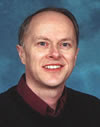What was
on the mind of a 61-year old minister who’d held several positions and had
taken on a new position not too many years earlier, as the 20th century
dawned? It shouldn’t have been too surprising that Elisha Albright Hoffman
considered what human characteristics someone carries with himself from one
place to another, and probably more importantly what he leans upon through
difficult circumstances. Hoffman had been through many places and various situations,
and so no doubt had concluded that he needed the words of “To Christ Be True” as
much as others who would sing its words, as the 1900s developed.
Many
years, songs, churches, and experiences were in Elisha Hoffman’s rearview
mirror in 1900, coloring what he would write as his newest ministry effort was
developing. He was in Benton Harbor, Michigan at the time, a place on the far
southeastern shore of Lake Michigan (see map), where he and his family had
been for some five years. The strong sense of duty and loyalty of which he
wrote in “To Christ Be True”, as well as the musicality he demonstrated in it,
was inbred probably during his upbringing by Christian parents, including his
father who was also a minister. Perhaps it was Hoffman’s first evident
exhibition of duty and loyalty, albeit a short one, that showed itself when he
volunteered in the Union Army in 1863 during the Civil War. His postwar
education at Union Seminary was a precursor to his work at the Evangelical Association
in Pennsylvania, following loyally in his father’s footsteps. During the next
decade, his first wife died, leaving him a widower with three sons. Elisha
would remarry and begin the first of four church ministry efforts by 1880;
Benton Harbor was the third. Along the way, Hoffman would edit scores of
hymnals and write some 2,000 hymns of his own, most of them probably while he
was in the Michigan ministry. He must have encountered countless numbers of
people in ministry by the time he reached three-score years, worshipped in various
churches, and thought about what God wanted from him and fellow believers. How
does one endure service in a war, suffer the loss of a young wife and have
single-parenthood thrust upon you, and move around to take on new ventures in
one’s chosen profession? By the time he reached 61, Elisha must have surmised
that God provides. Why wouldn’t some
choose to enlist in His army? Though his stint as a private in the Union Army
had been brief (about a month, reportedly), perhaps its imprint on Hoffman was one
of the most enduring of his life, including as he thought about loyalty to his
God. Were those battlefield images still in his thoughts as he wrote about
unfurling the Lord’s banner in conquest (v.1), volunteering for service (v.2),
and especially about confronting conflict (refrain)? Does God provide difficult
experiences so they propel us toward Him, and forward for the rest of life?
Elisha
may have asked himself, as any individual might after three decades, has this
been worth it? What other way has a better track record? One might imagine
Elisha telling others of his own episodes, and how he managed to come out the
other side. He’d had good examples, apparently, including his parents, but he
was molded by his own unique set of experiences too. In Benton Harbor, Elisha
reflected and realized, probably not for the first time, that he was God’s
tool, wielded in various places and despite—or perhaps because of—the
challenges he’d met. No one is like me, exactly. But, I have the same God
available to me as you. He can meld us all together to Himself, with this glue
called Christ-loyalty.
Brief
biography and list of composer’s works here: http://www.hymntime.com/tch/bio/h/o/f/hoffman_ea.htm
Site describes where composer was during the time: https://en.wikipedia.org/wiki/Benton_Harbor,_Michigan





